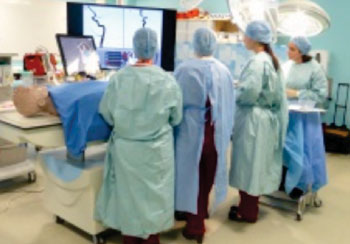Virtual Reality System Effective for Team Training in Acute Stroke
By HospiMedica International staff writers
Posted on 15 Jul 2015
A UK-based hospital has successfully used an innovative simulator to train physicians and staff in critical, life-saving interventional stroke treatment.Posted on 15 Jul 2015
Southend University Hospital (SUH) established an innovative interventional stroke service at Anglia Ruskin University (ARU) using the ANGIO Mentor Suite simulator by 3D Systems (3DS; Rock Hill, South Carolina, USA) for efficient, realistic team training for endovascular stroke treatment. The hospital found that running dedicated training courses in a true-to-life cath lab environment using a virtual-reality simulator – enhanced understanding of high-risk stroke procedures, strengthened collaboration, and increased communication skills across the various clinical teams involved in this complex procedure.

Image: The ANGIO Mentor Suite simulator was effectively used for hospital team training in life-saving interventional stroke treatment (Photo courtesy of 3D Systems).
Recent clinical studies have demonstrated for the first time that endovascular treatment (mechanical opening of brain artery) can improve stroke patient outcome. Only 1% of ischemic stroke patients currently receive this costly, potentially life-saving treatment. However, based on the positive outcome of these studies, this number is predicted to increase to 10%.
“In order to provide timely regional coverage for endovascular stroke treatment, more hospitals and physicians will need to provide endovascular stroke services. To practice this high-risk procedure, I believe procedural training on a virtual reality simulator such as the ANGIO Mentor Suite should be mandatory to provide an environment that is as close as possible to the actual setting when treating a patient,” said Prof. Iris Grunwald, diagnostic and interventional neuroradiologist at Southend University Hospital and director of Neuroscience and Vascular Simulation at Anglia Ruskin University.
3DS provides an end-to-end thread from surgical simulation and training to virtual surgical planning and 3D printing of anatomical models, surgical instruments, implants, and medical devices. It has held free webinars on Acute Ischemic Stroke Intervention as part of its education and training efforts, including demonstration of a step-by-step treatment path using the stroke module on the ANGIO Mentor simulator. 3DS exhibited its advanced healthcare training solutions, including virtual reality simulators and 3D printed models, at the Society in Europe for Simulation Applied to Medicine 2015 exhibition (SESAM; Belfast, Ireland; June 24–26).
Related Links:
3D Systems
Simbionix (of 3D Systems)














